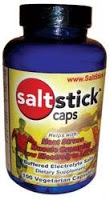 There is always a lot of talk about hydration and electrolytes for longer races and many an athlete gets scared off by the term “hyponetremic.” But, when do you actually need to start using electrolyte supplements? Don’t some of the gels and drinks have electrolytes in them? How much do you need per hour? Do you get enough sodium from your diet to compensate? Well, grab a salt shaker and have a quick read. Okay, not really. Grab some water with a Nuun tablet thrown in and then take a seat.
There is always a lot of talk about hydration and electrolytes for longer races and many an athlete gets scared off by the term “hyponetremic.” But, when do you actually need to start using electrolyte supplements? Don’t some of the gels and drinks have electrolytes in them? How much do you need per hour? Do you get enough sodium from your diet to compensate? Well, grab a salt shaker and have a quick read. Okay, not really. Grab some water with a Nuun tablet thrown in and then take a seat.
Daily intake
 First and foremost, let’s get the daily sodium thing straight. You don’t need more sodium added to what you are currently eating. Trust me, most Americans, athletes or not, need to cut back. But, you already knew that right! However, there are times in the day or two leading up to a long and hot race, that many a pro/elite athlete can be found adding salt to their meals more than normal. Just realize that these people aren’t doing this day in and day out. Only coming up to a race or during extreme training. For the rest of us, back away from the salt shaker… and canned goods…and frozen foods…and boxed meals…and restaurant food…and
First and foremost, let’s get the daily sodium thing straight. You don’t need more sodium added to what you are currently eating. Trust me, most Americans, athletes or not, need to cut back. But, you already knew that right! However, there are times in the day or two leading up to a long and hot race, that many a pro/elite athlete can be found adding salt to their meals more than normal. Just realize that these people aren’t doing this day in and day out. Only coming up to a race or during extreme training. For the rest of us, back away from the salt shaker… and canned goods…and frozen foods…and boxed meals…and restaurant food…and
 If your event is under 2 hours long: most gels and/or drinks will have enough in them to do the job. The only exception is if the weather is hot (80F+) and humid(65%+) or much hotter than you are used to. In that case, it is wise to take a one hour dose as outlined below.
If your event is under 2 hours long: most gels and/or drinks will have enough in them to do the job. The only exception is if the weather is hot (80F+) and humid(65%+) or much hotter than you are used to. In that case, it is wise to take a one hour dose as outlined below.
If your event is over 2 hours long: Now it is time to plan on taking in what you really need to perform and feel your best. This is a tough one because everyone’s needs are different. I have seen people say they are happy with 300mg of sodium an hour while others go with 500-600mg/hr. The most I have seen is 1000mg/hr for a hot and humid ironman.
Now is the time to plan out your nutrition intake for your race. You have got to sit down and take a look at what gel/drink you will be taking in for carb needs and find out how many electrolytes are already in them. Make sure you are getting all the electrolytes too. That means sodium, potassium, magnesium and calcium.
The average dose is going to be based off the sodium number with most athletes taking in about 300-500 mg/hour. If you are a heavy sweater with salt stains on your clothes, are racing in a hot, humid environment, and/or still experience cramping then up that hourly dose. Personally, I took in about 500-600mg/hour during Hawaii 70.3 and felt great.
Products
 Some people at electrolyte powders or drops to their drinks, but most people prefer to take capsules with them. Just remember to read the label for dosages and add that number to the sodium you will be consuming through other race day carbs. You can carry your gelcaps in a baggie that can be put in a racebelt or short pocket. Also, there is a cool little gadget for bikes and racebelts called saltstick that will hold your caps very well and are easy to get to. Another option is Nuun tablets that can be dropped into water or even put on your tongue to dissolve(well, at least that is what Desiree Ficker did when she took second at Ironman Hawaii.) The already come in a convenient dispenser.
Some people at electrolyte powders or drops to their drinks, but most people prefer to take capsules with them. Just remember to read the label for dosages and add that number to the sodium you will be consuming through other race day carbs. You can carry your gelcaps in a baggie that can be put in a racebelt or short pocket. Also, there is a cool little gadget for bikes and racebelts called saltstick that will hold your caps very well and are easy to get to. Another option is Nuun tablets that can be dropped into water or even put on your tongue to dissolve(well, at least that is what Desiree Ficker did when she took second at Ironman Hawaii.) The already come in a convenient dispenser.
We have all these products for you to try at SLRC so make sure to try out what you think you will need on your longer workouts. If you want to look at labels ahead of time, just click on the pictures and that will lead you to the product website. So now is the time to pick your poison and let the “good times” roll!
